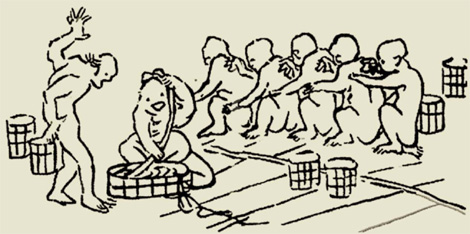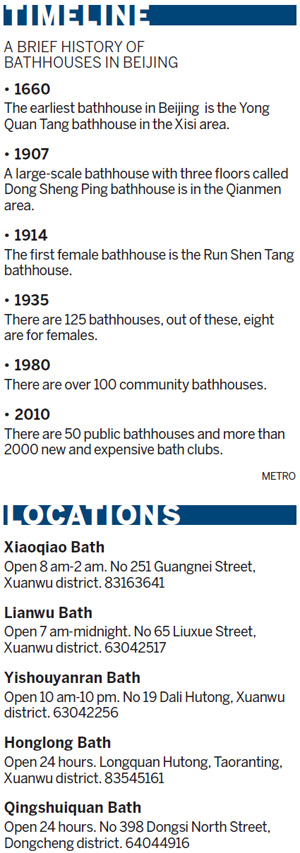The fall of an old bathing business
Communal bathhouses were part of everyday life in Beijing. But as lifestyles change, washing with others is becoming a thing of the past and the traditional public bathhouses are giving way to modern bathing complexes, Qin Zhongwei and Meng Jing report
Crowded, steamy and wet, the traditional public baths were, until two decades ago, the solution to Beijing's hygiene needs.
|
 An illustration from an ancient book depicts a bathing scene in Song Dynasty when the earliest bathhouse emerged. Sohu Travel Forum / Provided to China Daily |
Yan Cuizhen, a 49-year-old woman, used to regularly visit the public bathhouse near her house in Dali hutong, Xuanwu district until she moved to her apartment building in the 1990s.
"I often went there with my mother and sisters when I was a little girl. The admission fee at that time was only 0.26 yuan per person. But taking a bath was still a luxury, as my mother only earned about 10 yuan each month," she told METRO.
Recalling washing in the steamy and not-so-well-equipped bathrooms, Yan said people would come in happily with other family members, and in the women's section, the mothers would scrub each other's backs or wash their children's hair in the hot soaking pool, while children sang and played.
|
 |
Although there are many who view public bathhouses as a reminder of an impoverished past and are glad to see them go.
Others such as Yan take a more nostalgic view and look back to a time when a trip to a bathhouse was a sociable occasion where cleanliness and nakedness meant togetherness .
There used to be over a hundred such community bathhouses in the 1980s according to He Peiyun, vice-chairwoman of Beijing Bath Trade Association.
"But now, there are only around 50 left, due to more and more apartment buildings replacing the old courtyard hutongs and people are able to take baths or shower in their own homes, " she said.
At the same time, around 2,000 new and expensive bath clubs have emerged in the city in recent years, reducing the need for the traditional bathhouse still further.
Bathhouses vary considerably in size and amenities-from small establishments with 10 or 20 rooms and a handful of lockers to multi-storey saunas with a variety of room styles or sizes and several steam baths, jacuzzi tubs, and sometimes swimming pools.
Most have a steam room (or wet sauna), dry sauna, showers, lockers, and small private rooms.
It should be noted that many bathhouses are membership only.
Besides being places to wash, these modern bathhouses are more like recreational centers, as they provide buffets, spas, saunas, and other facilities. Meanwhile, the traditional bathhouses that are usually only equipped with hot soaking pools and some beds to relax on, are losing their popularity.
"For those traditional bathhouses whose sole function was letting people take a bath it is hard to make money now, " He said.
Runshen Bathhouse, which was the city's first public bathroom to cater exclusively to female customers, opened in 1914. It shut its doors in 2001 when there weren't enough customers to make it viable.
Managed by Zhou Meiling, a woman in her 30s who rented and redecorated the place, the bathhouse now exists as a small hotel with 30 standard rooms.
At a glance, nobody could identify that the two-storey building as a former favorite for women wanting to wash.
There is another small bathhouse, not far from Zhou's hotel, which is still open.
It has around 80 customers a day with 12 yuan per person. However, the majority of its customers are no longer Beijingers, but the increasing number of migrant workers who rent houses nearby.
Among the public bathhouses still surviving is Qinghuachi, one of Beijing's oldest bathhouses.
Relocated several times, the baths are now housed in a grand six-storey building at No. 17, Hufang Street, Xuanwu District. It enjoys over 700 customers every day and boasts that the majority of them are regulars.
However, the baths are now better known as the city's best chiropody center, with over 50 professional pedicurists providing various foot care services.
Wang Jiansheng, is Qinghuachi's most-acclaimed foot specialist, and he has worked at the baths since the 1970s.
He still remembers clearly his early days when Qinghuachi was still a small and steamy bathhouse.
"We worked in the bathhouse all the time, carrying a small stool and a box containing the pedicure tools.
"When people called me, I ran immediately to sit next to them. They rested their foot on my legs and I began to do the foot care. If someone is fat, my leg became tired very soon," Wang said.
It was not a well-paid job back then and people didn't view it as a serious profession.
But now, Qinghuachi has a big office for each pedicurist on the second floor and it is totally a different picture.
With a big special-designed sofa for his clients and a comfortable chair for himself, Wang's clients include celebrities and top officials.
However, while the bathhouse revels in its fame there are those that say the bathhouse is now longer the baths of old one and only the name is same.
Chen, 52, who often visited the old Qinghuachi before its final relocation, still recalls the days when he and his pals sang Peking Opera loudly and laughed in the steaming bathhouse and soaked in the hot pool for half a day.
"I really miss that," he said.


















